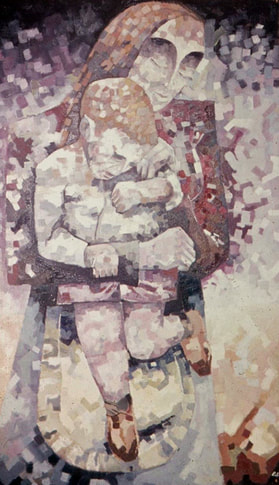|
While preparing for a talk ('Paris, City of Art') later this month, I was looking for images of late 19th century Montmartre and came across a particularly interesting photograph of the Maquis, the area around the Butte de Montmartre. Apparently it was taken between 1887 and 1889, and shows a hillside covered in what look like allotments with huts of various sizes. This semi-rural area, whether vegetable gardens or shanty town, would be obliterated by rapid urban development in just a few years. The composition of the photograph (in fact, cropped from a wider view, I discovered later) was arresting - the bend in the track, the huts stacked cubist-style on the hill, and at the top, a mill (the Moulin de Galette in its original location), and a long barn-like structure. But the allotments themselves also fascinated me, looking so similar to the ones just a short walk from my house in Japan, and knowing that the Maquis would soon disappear gives the ramshackle scene an extra poignancy. I also found a number of van Gogh paintings of Montmartre, including some of the Maquis. I realized that one in his darker manner, dated 1886, depicted virtually the same view as the photograph. Areas of untended land and the absence of some structures clearly show that the painting was made before the photograph was taken, but the features common to both are virtually identical. Perhaps unreasonably, I was surprised to see how accurately van Gogh had portrayed the scene, and how he had shown those humble shacks such respect.
0 Comments
I think I was 16 when I painted this. I was already influenced by Cézanne, and the blocky style was my naive interpretation of his style. Even from this image, carefully Photoshopped from an old snap, it's pretty obvious that I had no idea of what he was really on about, but I think it has a certain presence. The painting (oil on hardboard) was about six feet high and for years was stored at the back of my parents' garage and went to the tip when my father died. An extract from Oliver Sack's 'The River of Consciousness', quoted in a New York Times article today:
"It is often felt that Darwin, more than anyone, banished “meaning” from the world — in the sense of any overall divine meaning or purpose.…. [And yet] evolutionary theory provided, for many of us, a sense of deep meaning and satisfaction that belief in a divine plan had never achieved. The world that presented itself to us became a transparent surface, through which one could see the whole history of life. The idea that it could have worked out differently, that dinosaurs might still be roaming the earth or that human beings might never have evolved, was a dizzying one. It made life seem all the more precious and a wonderful, ongoing adventure." Exactly. |



 RSS Feed
RSS Feed